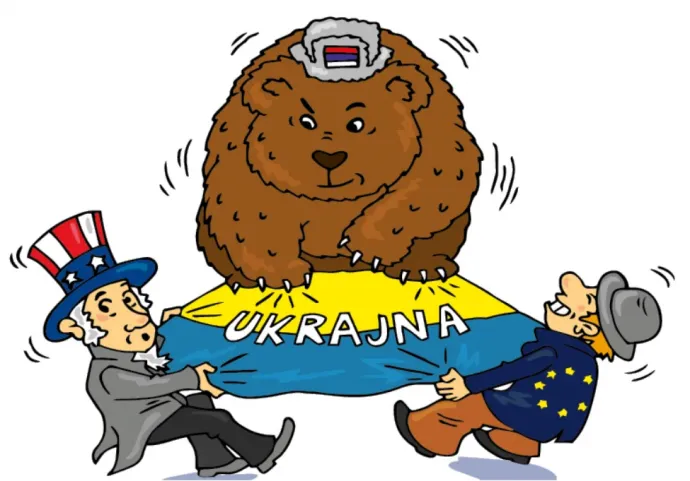There are several distortions of history in the new Russian 11th grade history textbook, which Putin's adviser Vladimir Medinsky was commissioned to write. Although the textbook turned out to be more of a propaganda publication aimed at reinforcing "patriotic education", it will be compulsory in schools in Russia beginning in September. The textbook was sent to G7 by the editorial office of Meduza. The publication devotes
- nearly 100 pages to Putin's rule
- 18 pages to the "special military operation", i.e. the war in Ukraine,
- and calls the Hungarian revolutionaries of '56 fascists.
The new textbook makes the most detailed mention of Hungary in relation to the events in 1956 – although there are only two paragraphs devoted to it, and it is illustrated with the photo of the toppling of the Stalin statue. According to the text
“In many Eastern European countries, the anti-Soviet forces made use of the criticism of Stalin's personality cult (...). The Hungarian crisis was triggered by the actions of the West's secret services and the internal opposition they supported. The Soviet Union sent troops to Hungary and helped the Hungarian authorities crush the protests.”
Just like with Ukraine's Orange Revolution, where the Russian narrative presents America and fascism as the main enemies, the same is done with the events of 1956.
Russian children will thus learn about radicals with a fascist past and Western intelligence operations in relation to the Hungarian Revolution in 1956.
Putin's Russia has thus returned to the Soviet interpretation of '56.
A painful blow for Fidesz
Hungary's latest National Curriculum, introduced in 2020 (NAT 2020) was also designed to strengthen "national identity". The rewritten Hungarian textbooks place emphasis on patriotic education. Some may recall that the new, revised Hungarian textbooks also have a rather liberal approach to history; last September, for example, we wrote about the illustration used by the authors in the 8th grade geography textbook to explain the war in Ukraine:

With the arrival of the new National Curriculum, teaching about national defence was also introduced as part of civic education, so that the necessary "norms" could be passed on. In addition, following the introduction of the NAT 2020, the atmosphere escalated almost to hysteria regarding the subjects of Hungarian and history: protests and petitions were launched, old and new teachers' organisations welcomed or criticised the material, and political parties demanded its withdrawal.
It seems, however, that in spite of including the above illustration – no doubt dear to the Russians – about Ukraine in Hungarian textbooks, the Russian book has now hit the Hungarian government in a sensitive spot: 1956 and the heroes of the revolution have been important in the communication of Fidesz and those close to Fidesz. For example, 1956 has come up when Zoltán Kovács (State Secretary for International Communication) decided to say that Ferenc Gyurcsány (opposition MP with Demokratikus Koalíció and former PM) even opposes ‘56. But it’s also come up when the KDNP (the smaller party in the governing coalition) considered it important to claim that "in the past, Hungarian families had to be protected from Soviet tanks, while today they have to be protected from the "Brussels sanctions".
Fidesz' appropriation of '56 is also shown in how fighting against the east gradually disappeared from Orbán's speeches and how the revolution has become a communication ploy when talking about Brussels. While on 23 October 2007 Orbán said that "looking back from the top, one can really see that in 1956 we fought a revolution against the East", in his later, more recent speeches, 1956 is less and less about the struggle between the Eastern and Western world order, and it certainly hasn't got anything to do with the Hungarians' desire to belong to the West.
By 2022, Orbán's interpretation of 1956 was that we must fight for peace negotiations, and that the West betrayed us. But the situation was similar in 2021, when the government spent 23 October criticizing the left and Gyurcsány.
Some billboards – most likely addressed to the Hungarian government – appeared in Transcarpathia earlier this year, implying that the parallel between '56 and the current war in Ukraine seems to be forgotten in Hungary's current communication. The text on them suggested that while in 1956, Russia was killing Hungary, it's been doing the same with Ukraine since 2014. Appropriately, one half of the billboard had a photo from the Corvin alley in Budapest, a legendary location of the 1956 revolution, and the other half showed a shot up Ukrainian building.
The Hungarian government's propaganda machinery attempted to defend the parallels with '56 by inviting a journalist of the Russian state news agency to the editorial office of Pestisrácok to discuss for example, that (a direct quote from their report) "Soros' network and US Ambassador David Pressman are claiming that the Hungarians betrayed the 1956 struggle for freedom". The paper then argued that "in 1956, the freedom fighters fought against the totalitarian communist regime and the Red Army in a very different historical setting" – although the above example shows that it is futile for Hungary to emphasise the difference between the 1956 revolution and the Ukrainian uprising, the history rewritten by Putin is not likely to notice it.
For more quick, accurate and impartial news from and about Hungary, subscribe to the Telex English newsletter!